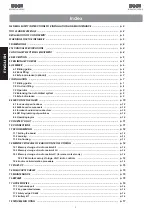
7251 / 7351 Slide Gate Operator
INSTALLATION AND PROGRAMMING MANUAL
10
www.hysecurity.com • 800-321-9947
MX4514 Rev. A ©2019
any safety edges used to protect the close direction. The
gate should stop, or, stop and reverse.
o
Bstruction
t
est
- o
peninG
Using a suitable obstruction in the path of the gate (a solid,
immovable object), run the gate in the open direction until it
contacts the obstruction. The gate should stop and reverse.
ENTRAPMENT PROTECTION
The UL325 standard for gate operators requires a minimum
of two independent entrapment protection means for each
entrapment zone. An entrapment zone is defined as follows:
For slide gates, any locations between a moving gate and
a counter opposing edge or surface where entrapment is
possible up to a height of 6 ft. (1.83 m) above grade. Such
locations occur if at any point in travel if the gap between
a moving gate and the fixed counter opposing edges or
surfaces is less than 16 inch (406 mm).
For swing gates, locations between a moving gate or moving,
exposed operator components and a counter opposing
edge or surface where entrapment is possible up to 6 feet
(1.83m) above grade. Such locations occur if during any
point in travel:
a. The gap between the bottom of a moving gate and the
ground is greater than 4 inch (101.6 mm) and less than
16 inch (406 mm); or
b. The distance between the center line of the pivot
and the end of the wall, pillar, or column to which it is
mounted when in the open or closed position exceeds 4
inch (101.6 mm). Any other gap between a moving gate
and fixed counter opposing edges or surfaces or other
fixed objects is less than 16 inch (406 mm) (examples
are walls, curbs, berms or other immovable objects).
c. Potential entrapment zones are shown in INSTRUCTION
6, IMAGE 6-1 & for slide gates, but there may be other
entrapment zones presented by the actual installation and
adjacent structures or landscape that must be protected
as well. All Nice gate operators feature an Inherent
Entrapment System (IES) (UL325 Type A) that monitors the
force on the gate during travel. This system protects in
both the open and close direction and reverses on contact
with an obstruction. This IES system serves as one of the
means of entrapment protection.
External sensors must be used to protect against entrapment
at each location where an entrapment zone exists. The
minimum number of external sensors required to enable
automatic operation of the swing gate is one sensor in the
close direction (provided the gate in the open direction
presents no risk of entrapment.)
The gate operator tests for the presence of at least one
functioning sensor, and if not found, the operator will only run
using continuous pressure on an Open/Close button, either
on the controller, or an external device.
SENSORS AND ACCESSORIES
Instructions are provided in this manual for installation of the
photo eye transmitter/receiver pair per UL325 requirements,
and separate instructions are included if other sensor types
are included in the kit. If other sensors are used to avoid
entrapment scenarios, ensure the following:
• Non-contact and contact sensors must be installed
individually or in combination with each other to provide
external entrapment protection.
• Care should be exercised to reduce the risk of nuisance
tripping, such as when a vehicle trips the sensor while
the gate is still moving, and one or more non-contact
sensors shall be located where the risk of entrapment or
obstruction exists, such as the perimeter reachable by a
moving gate or barrier.
• A hardwired contact sensor shall be located and its wiring
arranged so that the communication between the sensor
and the gate operator is not subjected to mechanical
damage.
• A wireless contact sensor such as one that transmits
radio frequency (RF) signals to the gate operator for
entrapment protection functions shall be located where
the transmission of the signals are not obstructed or
impeded by building structures, natural landscaping or
similar obstruction.
COMPATIBLE EXTERNAL SENSORS
Only the following external sensors have been evaluated and
tested with Nice 1050 control boards and are approved to be
used for protection against entrapment:
• Nice BlueBUS Through-Beam Photo Eye
• ASO Sentir Series Contact Edge
• Miller Edge GEM-103 Edge Sensor Converter
•
EMX IRB-RET Retro-Reflective Photo Eye
•
EMX NIR-50-325 Retro-Reflective Photo Eye
• EMX WEL-200 Wireless Edge Transmitter/Receiver











































